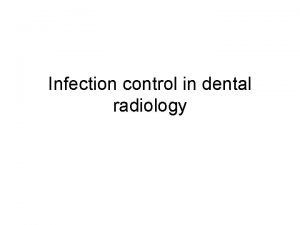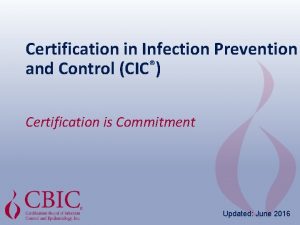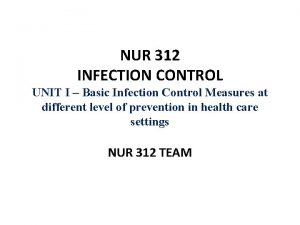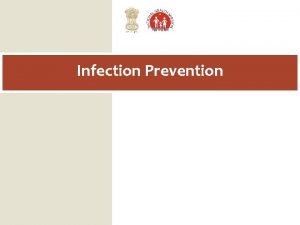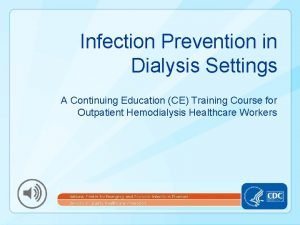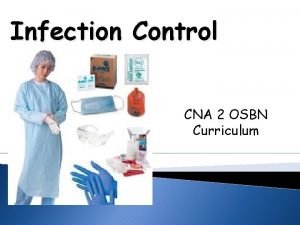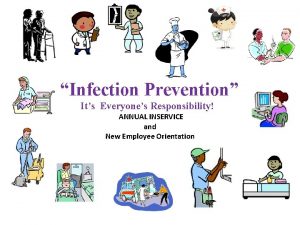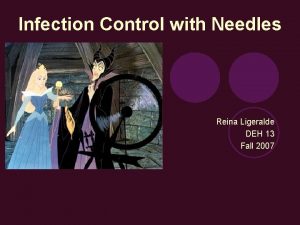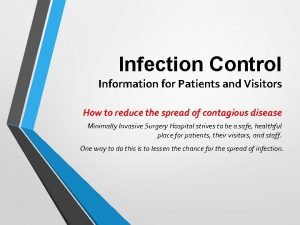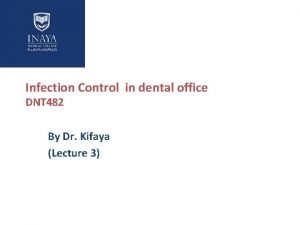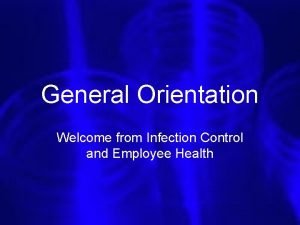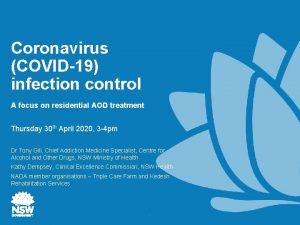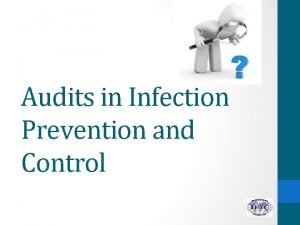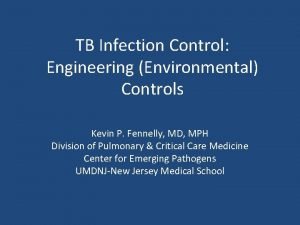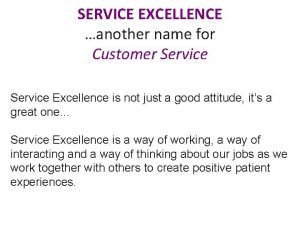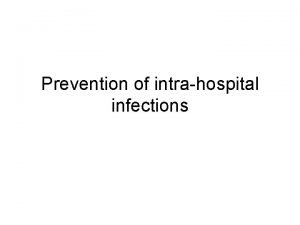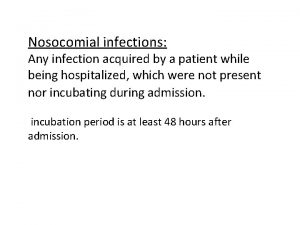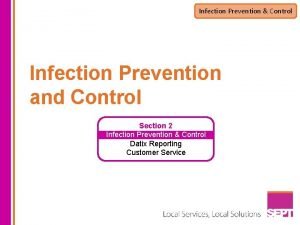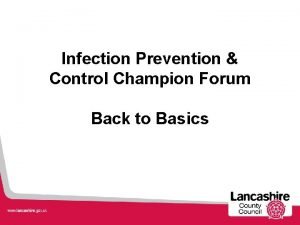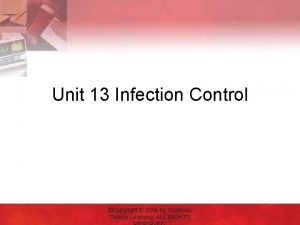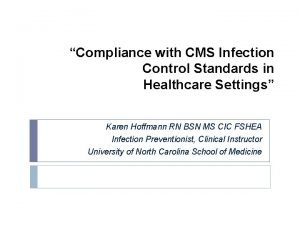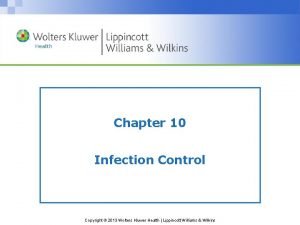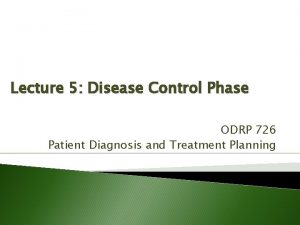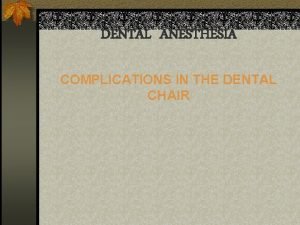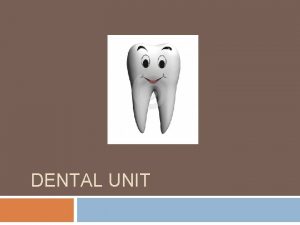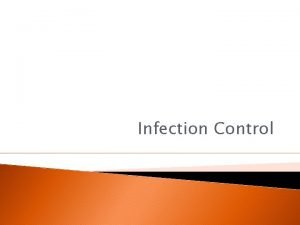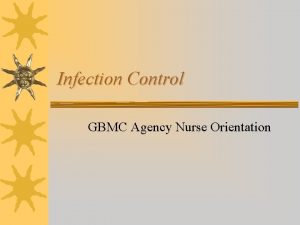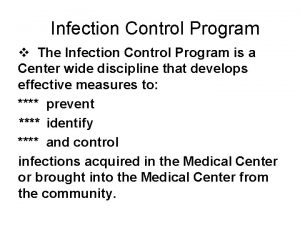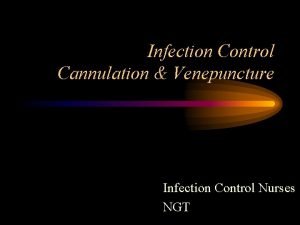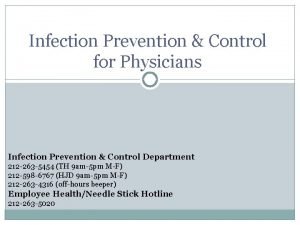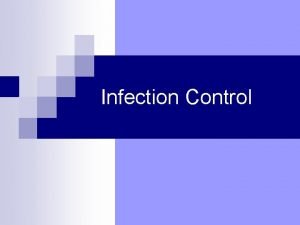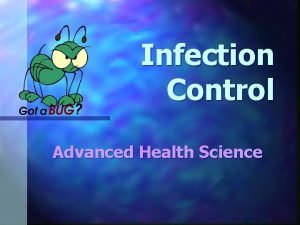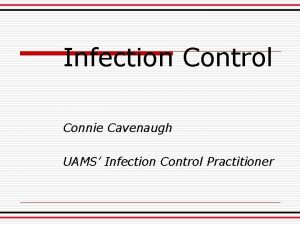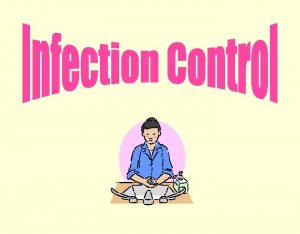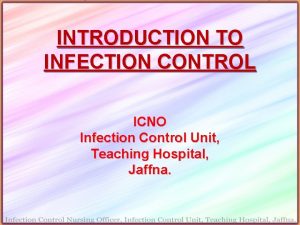CDCs Guidelines for Infection Control in the Dental































































- Slides: 63

CDC’s Guidelines for Infection Control in the Dental Operatory Pamela Alston, DDS, MPP 12/26/2021

CDC Guidelines z CDC staff collaborated with infection control experts z Evidence-based z Strong theoretical rationale, respected opinions z In-depth review process 12/26/2021

Job Corps’ Policy and Requirement z “The center shall use protective measures as recommended by the CDC. ”—PRH-6. 12 (R 13)(b) 12/26/2021

Applicable DHCP z“All paid or unpaid dental healthcare personnel who might be occupationally exposed to blood and body fluids by direct contact or through contact with contaminated supplies, equipment, environmental surfaces, water, or air” 12/26/2021

Microbes in the Mouth z. Mouth is most important infectious disease agent source zmicrobes must escape from the source 12/26/2021

Chain of Infection ÊPathogenic organism Ëa suitable source that allows microorganism to survive and multiply Ìmode of escape from source Ímechanism of transmission Îportal of entry Ïa susceptible host 12/26/2021

Infectious Disease Transmission z Exposure to all blood and other potentially infected materials z From patient to dental worker z Dental worker to patient z Patient to patient 12/26/2021

Transmission in Dental Setting ÊDirect contact with body fluids ËIndirect contact with contaminated objects ÌContact of conjuctival, nasal, or oral mucosa with droplets ÍInhalation of airborne microorganisms suspended in air 12/26/2021

Goal of Infection Control To reduce the dose of microbes shared among people 12/26/2021

In the Dental Setting *Treat all patients as potentially infectious *Use personal protective equipment *proper sharps handling techniques *Receive immunizations *Limit contamination *Wash hands *Sterilize if you can *implement safe work practices 12/26/2021

Ways to Prevent Transmission z. Standard precautions z. Engineering Controls z. Work Practice Controls 12/26/2021

Standard Precautions z z z 12/26/2021 Blood All body fluids, secretions/excretions Non-intact skin Mucous membranes Doesn’t include sweat

Personal Protective Equipment z. Use whenever potentially infectious materials could contact skin or mucous membranes z. Includes: y y 12/26/2021 Gloves Masks Eye and face protectors Gowns

Patient Barrier Preferences z“Dental clinical attire and infection-control procedures: Patient Attitudes, ” Shulman ER, Brehm WT, JADA 2001 z. Masks for DDS 77% (tx)/74% (exams) z. Eyewear for DDS 54% (tx)/43% (exams) z. Eyewear for Patient 19% z. Surface barriers 63% 12/26/2021

Gloves z When contact with body fluids is expected z New pair for each patient, sooner if damaged z Removed and hygiene performed promptly after use z Available in correct size and readily accessible z Puncture resistant gloves for housekeeping, handling contaminated instruments 12/26/2021

Dermatitis z. Weeping dermatitis z. Irritant contact dermatitis zallergic contact dermatitis 12/26/2021

Latex Allergy z“Type I hypersensitivity to latex proteins” zserious whole-body allergic reaction zskin, nose, and eye symptoms zmore severe symptoms: asthma, cardiovascular, and gastrointestinal symptoms 12/26/2021

Latex Allergy z. Screen all patients for latex allergy zconsider sources of latex other than gloves zschedule latex allergic patients for the first appointment of the day zhave latex-free kits available zmanage latex-related complications during or after a procedure 12/26/2021

Hand Hygiene éPrior to glove placement and removal éAfter accidental barehanded contact with objects likely to be contaminated éBefore leaving the treatment area 12/26/2021

CDC’s Handwashing Guidelines To improve hand hygiene practices and reduce health care-acquired infections: 4 Wash hands with a non-antimicrobial soap and water when hands are visibly dirty or contaminated 4 Use an alcohol-based waterless antiseptic agent routinely 12/26/2021

CDC’s Handwashing Guidelines l Don’t add soap to partially empty soap dispenser l Provide health care workers with hand lotions l Do not wear artificial fingernails or extenders 12/26/2021

Employer Obligations vprovide handwashing facilities for employees vensure that employees wash their hands ASAP following contact with blood or saliva vensure that employees wash their hands after removing PPE 12/26/2021

Handwashing Technique *Lather hands with soap and water *Rub vigorously for >9 seconds *Rinse hands 2 -3 times *Rinse under a stream of water *Dry with a disposable towel 12/26/2021

Hand Hygiene z. Liquid hand-care products stored in closed containers z. Hand lotions used to prevent skin dryness associated with handwashing z. Hand lotions free of petroleum and compatible with antiseptics 12/26/2021

Gowns z. Required whenever risky materials are likely to splash or spill; during any procedure where fluids could soak through clothing zbarrier to contaminants zcomfortable 12/26/2021

Linens z. Handle linens soiled with blood or OPIM as little as possible z. Bag soiled linen z. Use standard laundry cycles; neither HIV nor HBV can survive standard laundry cycles 12/26/2021

Masks z. Required for whenever blood and other risky materials could splash, splatter, or spray into face zsizing zfiltration efficiency of 95% for particles 3 to 5 microns in diameter zcomfort 12/26/2021

Eye Protectors z. Required for whenever risky materials could splash, splatter, or spray into your face zimpact resistance zside protection zsuited for specific applications in practice 12/26/2021

Safe Work Practices Before Tx z. Make sure all items needed for treatment are present zremove unnecessary supplies and equipment from the operatory zuse barriers 12/26/2021

Mouthrinses z. Scientific evidence is inconclusive about pre-treatment use z. Reduce microbial levels z. CDC offers no recommendation 12/26/2021

Safe Work Practices During Tx z. Wear PPE z. Use rubber dams z. Use high volume saliva evacuation z. Touch as few operatory surfaces as possible zone-handed scoop technique for recapping 12/26/2021

Safe Work Practices After Tx zdisposable needles in a punctureresistant container z. Spray uncovered operatory surfaces with a disinfectant zflush the waterlines zcover tray of instruments when they are transported 12/26/2021

Sharps Management z Place all disposable sharps in sharps disposal containers that must be: y. Readily available in all patient care areas y. Clearly marked y. Closable y. Puncture-resistant y. Maintained in upright position z Remove disposal containers before they become three quarters full 12/26/2021

Sharps Safety z. Place contaminated reusable sharp instruments in appropriate containers until processed 12/26/2021

Clean-up & Decontamination z. Wear protective gloves to clean up spills of blood, body fluids, or tissue z. Wear mask to minimize inhalation z. Wear eyewear z. Use standard cleaning and decontamination procedures for reusable equipment, floors, and walls 12/26/2021

Levels of Disinfection zhigh-level disinfection zintermediate-level disinfection zlow-level disinfection 12/26/2021

The Perfect Disinfectant zbroad-spectrum antimicrobial activity z. Acts quickly zunaffected by bioburden znontoxic and hypoallergenic znon-staining and compatible zeconomical lengthy shelf life zno harsh smell 12/26/2021

No Single Best Choice z Make a list of the characteristics of your practice z Rank the performance characteristics you want in the disinfectants you use z Compare your list with the advantages and disadvantages of today’s disinfectants 12/26/2021

Choosing a Disinfectant z. Choose an EPA-registered, tuberculocidal disinfectant zcleans and disinfects z. For agents requiring dilution prior to use, use water rather than alcohol 12/26/2021

EPA Surface Disinfectants z. Chlorines z. Complex phenols z. Dual/synergized quaternary ammonium compounds z. Iodophors z. Phenol-alcohol combinations z. Other halogens (sodium bromide and chlorine) 12/26/2021

Read the Label z. Know: y y 12/26/2021 What you are using Why you are using it How it should be used What precautions you need to use it safely

“What do I want from my solutions? ” z. Can one solution do the work of two? z. Are workers in the office using each product as directed? z. Are the solutions we’re using appropriate for their application in the practice? 12/26/2021

Hazard Communication Standard z. Container labeling z. Material safety data sheets z. Employee information and training z. Hazardous chemicals lists in each work area 12/26/2021

Compliance Organizations z. ADA—appropriate disinfectants for oral health practices z. CDC—disinfectant criteria and choices for dental applications z. EPA—list of registered antimicrobial pesticides including low and intermediate level antimicrobials z. FDA—high-level disinfectants & sterilants 12/26/2021

Surface Disinfection Process z Clean the surface by spraying with cleaner/disinfectant and vigorously wiping with paper towels z Spray the pre-cleaned surface with disinfectant z Allow surface to remain moist for the contact time recommended by the manufacturer z Wipe dry before seating patient 12/26/2021

Modified CDC/Spaulding z. Critical items—penetrate tissues; high risk of disease z. Semicritical items—contact mucosa; intermediate risk z. Noncritical items with intraoral contact— may contact skin and/or mucous membranes of dental personnel or patients; low risk 12/26/2021

Modified CDC/Spaulding (continued) z. Noncritical items with no intraoral contact —contact with unbroken skin; low risk z. Environmental surfaces: patient care— usually contact DHCP but not patients; very low risk z. Environmental surfaces: housekeeping — minimal risk 12/26/2021

Surface Barriers z. Eliminates the need for between-patient cleaning and disinfection z. Time-saving option for clinical contact surfaces that are difficult to clean 12/26/2021

Infection Control Assurance 3 All infection control practices are always consistent with written procedures 3 all infection control equipment is used according to directions 3 all infection control products are used properly 3 all infection control products are disposed of properly 12/26/2021

Dental Unit Waterline Quality z. Biofilm forms and acts as a reservoir z. Dental unit water has been found to be grossly contaminated with waterborne microorganisms zfor nonsurgical procedures CFU should be < or = 500 (CDC) 12/26/2021

Improving Waterline Quality z. Anti-retraction devices in dental unit water lines shall be installed and maintained zflush water lines at beginning of day zrun any dental device connected to a dental water system to discharge water and air for 20 -30 seconds after each patient (CDC) 12/26/2021

Housekeeping Schedules z. Create monthly dental office calendar listing chores z. Include periodic maintenance, recordkeeping, and infection control activities z. Consider kinds of products, the practice type, and patient volume z. Always follow equipment manufacturer’s instructions 12/26/2021

Project a Safe Practice Image z. Wash hands and wear gloves. z. Wear proper clothing in the reception area. z. Open packaged sterilized instruments in front of the patient. z. Offer patient eyewear. z. Offer a pre-treatment mouthrinse. 12/26/2021

Cost-Effectiveness z. Compare outright and backend costs z. Cost and user satisfaction zgo with reuse items instead of disposables 12/26/2021

Risk of Occupational Exposure z. Prevalence in the patient population znature of contact with blood and bloody fluids zfrequency of contact with blood and bloody fluids 12/26/2021

High Risk Tasks/Situations z. Using, handling, cleaning, and disposing of used needles or contaminated sharps z. Invasive procedures z. Any task where infectious materials could spill, splatter, or splash z. Any situation where large amounts of blood are present 12/26/2021

Risk Factors z. Route of exposure z. Dose of the virus transferred during an exposure incident z. Differences in host susceptibility z. Possible variations in the infectiveness of the infected patient z. Number of exposure incidents 12/26/2021

Characteristics to Determine Exposure Type z. Exposure type ztype of device zvisible blood depth of injury 12/26/2021

Risk of Transmission z 10 -30 out of every 100 needlestick injuries involving known HBV contamination transmit infection z 4 out of 1, 000 needlestick injuries involving needles contaminated with HIV will transmit infection 12/26/2021

Dental Setting Transmission z. As of 6/2001, no DHCP with documented HIV seroconversion following a specific occupational exposure to a known HIVinfected source z. HIV transmission from provider to patient —almost undetectable z. HIV Transmission from patient to patient —no documented evidence in oral health settings 12/26/2021

Decreasing Percutaneous Injuries z. Safer work practices zsafer instrumentation or design zcontinued worker education zpercutaneous injuries generally occur outside the patient’s mouth, involve very small amounts of blood, and are caused by sharps 12/26/2021

In Conclusion z z Take actions to stay healthy Avoid contact with blood Limit the spread of blood Make objects safe for use 12/26/2021

In summary--z. Use appropriate engineering controls to limit the risk of accidental exposure z. Apply work practice controls z. Wear personal protective equipment (PPE) that is suitable for the procedure z. Receive regular immunizations 12/26/2021
 Darkroom infection control guidelines
Darkroom infection control guidelines Infection control in dental radiology ppt
Infection control in dental radiology ppt Quats definition cosmetology
Quats definition cosmetology Chapter 16 infection prevention and control
Chapter 16 infection prevention and control Chapter 16 infection control and standard precautions
Chapter 16 infection control and standard precautions Chapter 15:8 using sterile techniques
Chapter 15:8 using sterile techniques One celled plantlike organisms that multiply rapidly
One celled plantlike organisms that multiply rapidly Certification in infection control cic
Certification in infection control cic Infection control definition
Infection control definition Learning objectives for infection control
Learning objectives for infection control Conclusion of infection
Conclusion of infection Neutropenic precautions
Neutropenic precautions Certification board of infection control and epidemiology
Certification board of infection control and epidemiology Infection control is everyone's responsibility
Infection control is everyone's responsibility Infection control
Infection control Infection control
Infection control Infection control information
Infection control information Root locus drawer
Root locus drawer Infection control orientation
Infection control orientation Infection control
Infection control Infection control audits
Infection control audits Environmental controls infection control
Environmental controls infection control Examples of service excellence in healthcare
Examples of service excellence in healthcare Infection control committee
Infection control committee Conclusion of infection control
Conclusion of infection control Rigid thinking examples
Rigid thinking examples Infection control champion
Infection control champion Unit 13 infection control
Unit 13 infection control Infection control surveyor worksheet
Infection control surveyor worksheet Chapter 10 infection control
Chapter 10 infection control The disease-control phase of treatment includes
The disease-control phase of treatment includes Dental moisture control
Dental moisture control Formuö
Formuö Typiska novell drag
Typiska novell drag Tack för att ni lyssnade bild
Tack för att ni lyssnade bild Vad står k.r.å.k.a.n för
Vad står k.r.å.k.a.n för Shingelfrisyren
Shingelfrisyren En lathund för arbete med kontinuitetshantering
En lathund för arbete med kontinuitetshantering Personalliggare bygg undantag
Personalliggare bygg undantag Personlig tidbok för yrkesförare
Personlig tidbok för yrkesförare Sura för anatom
Sura för anatom Vad är densitet
Vad är densitet Datorkunskap för nybörjare
Datorkunskap för nybörjare Stig kerman
Stig kerman Debatt artikel mall
Debatt artikel mall Autokratiskt ledarskap
Autokratiskt ledarskap Nyckelkompetenser för livslångt lärande
Nyckelkompetenser för livslångt lärande Påbyggnader för flakfordon
Påbyggnader för flakfordon Lufttryck formel
Lufttryck formel Svenskt ramverk för digital samverkan
Svenskt ramverk för digital samverkan Kyssande vind
Kyssande vind Presentera för publik crossboss
Presentera för publik crossboss Argument för teckenspråk som minoritetsspråk
Argument för teckenspråk som minoritetsspråk Bat mitza
Bat mitza Treserva lathund
Treserva lathund Luftstrupen för medicinare
Luftstrupen för medicinare Claes martinsson
Claes martinsson Cks
Cks Programskede byggprocessen
Programskede byggprocessen Mat för unga idrottare
Mat för unga idrottare Verktyg för automatisering av utbetalningar
Verktyg för automatisering av utbetalningar Rutin för avvikelsehantering
Rutin för avvikelsehantering Smärtskolan kunskap för livet
Smärtskolan kunskap för livet Ministerstyre för och nackdelar
Ministerstyre för och nackdelar
